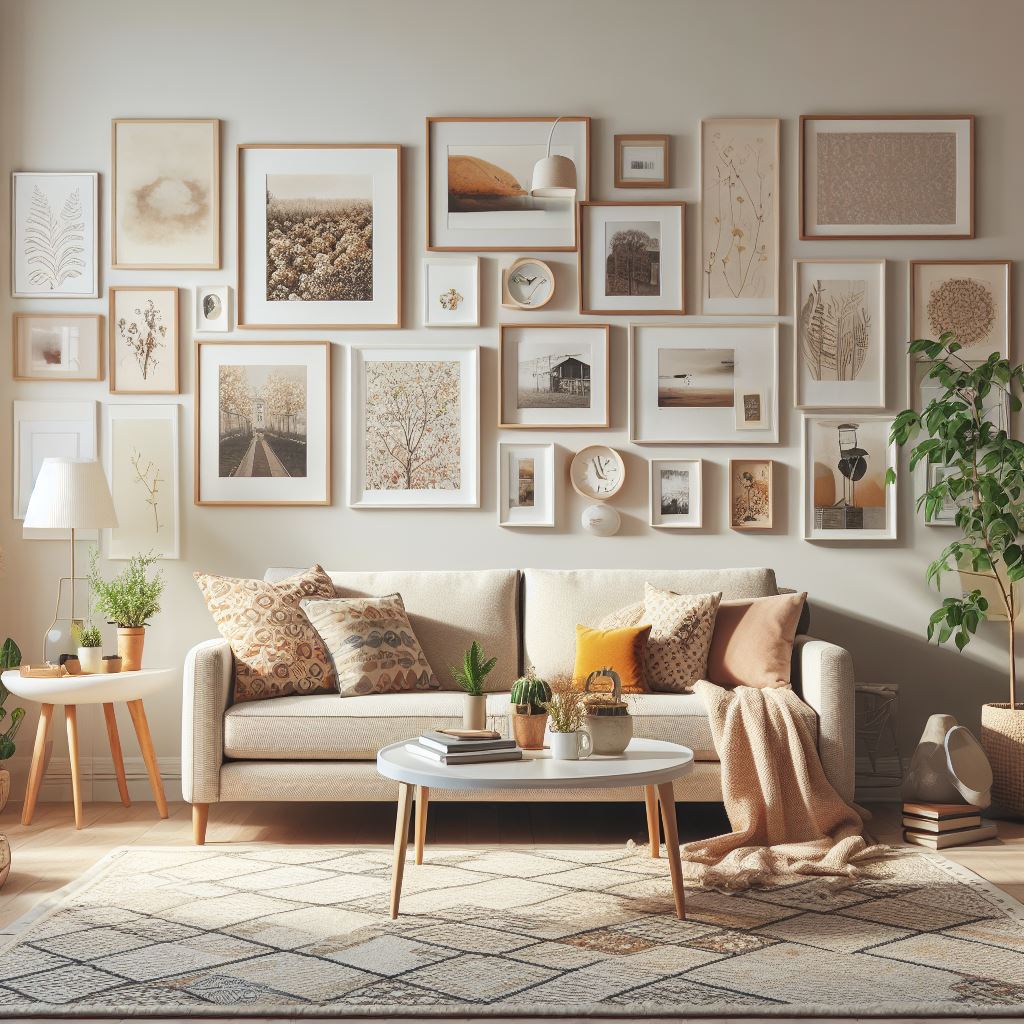Are you looking to spruce up your living space and showcase your favorite pieces of art and photographs? Look no further! This article will guide you through the simple steps of creating a gallery wall that will add charm and personality to any room. From choosing the right layout and frames to arranging the pieces in a visually appealing way, you’ll learn all the tips and tricks to create a stunning gallery wall that will be the envy of your friends and family. So, grab a hammer, unleash your creativity, and let’s get started on transforming your blank walls into your very own curated masterpiece! Creating a gallery wall is a fantastic way to showcase your personality and bring life to a blank wall. Whether you’re a seasoned art connoisseur or a beginner with an eye for design, these step-by-step instructions will guide you through the process of choosing a theme, selecting artwork, creating a layout, preparing the wall, arranging and hanging your artwork, adding personal touches, accessorizing the space, maintaining and caring for your gallery wall, updating the gallery, and seeking professional help if needed.
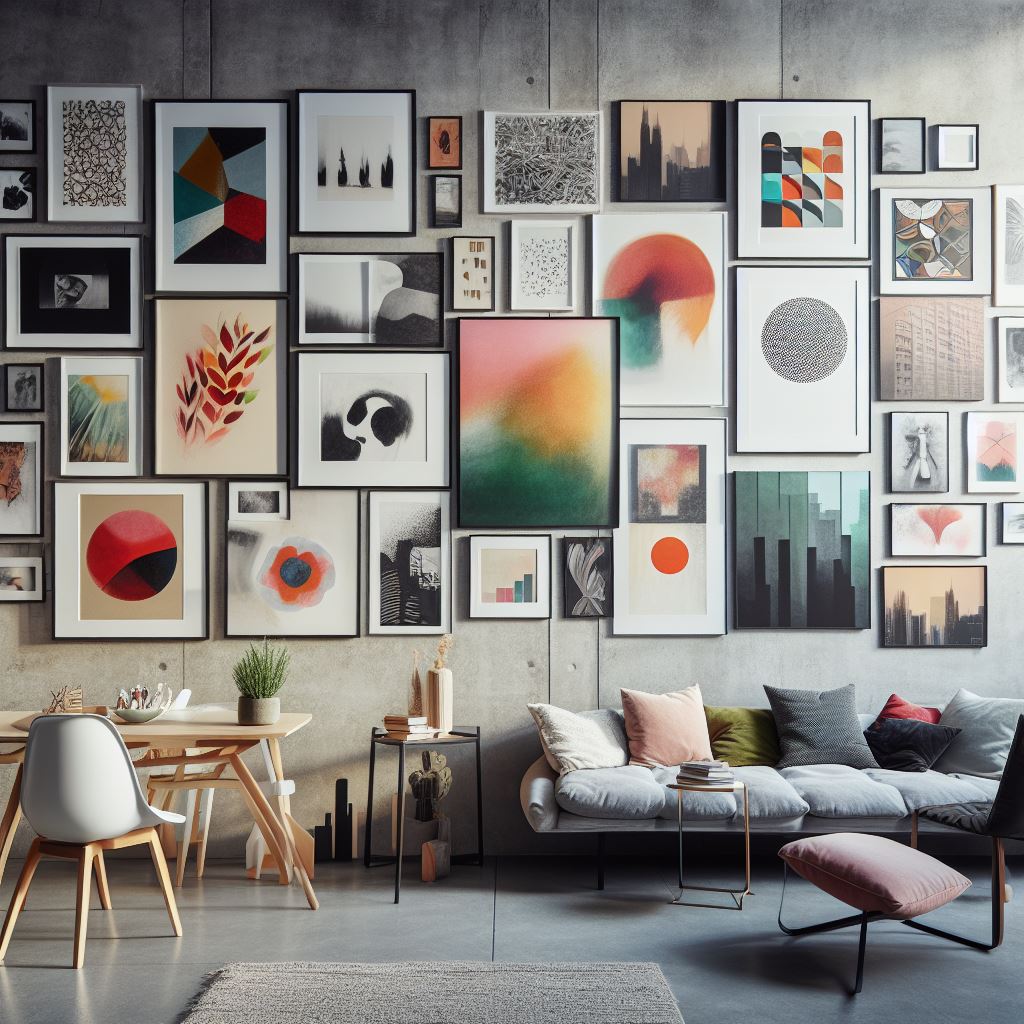
Choosing a Theme
When creating a gallery wall, it’s essential to decide on a cohesive theme to tie everything together. A theme can be as broad as a specific color palette or as specific as a particular art movement or genre. Consider your personal style and the overall aesthetic of your space. Do you lean towards a more traditional or modern look? Are you drawn to landscapes, abstract art, or photography? Think about the emotions and atmosphere you want to evoke with your gallery wall, as this will help guide your choices.
Consider the overall style of your space
To ensure your gallery wall complements the rest of your decor, take into account the overall style of your space. If your home has a minimalist feel, consider choosing artwork with clean lines and simple designs. If your space is more eclectic, you can mix and match different art styles for an eye-catching display. By considering the existing style of your space, you can create a gallery wall that seamlessly integrates with your overall design aesthetic.
Explore different art styles
Don’t limit yourself to a single art style when curating your gallery wall. Mixing different art styles can add visual interest and depth. Experiment with various mediums, such as paintings, prints, photographs, and even sculptures. By incorporating a variety of styles, you can create a dynamic and eclectic display that reflects your unique personality and interests.
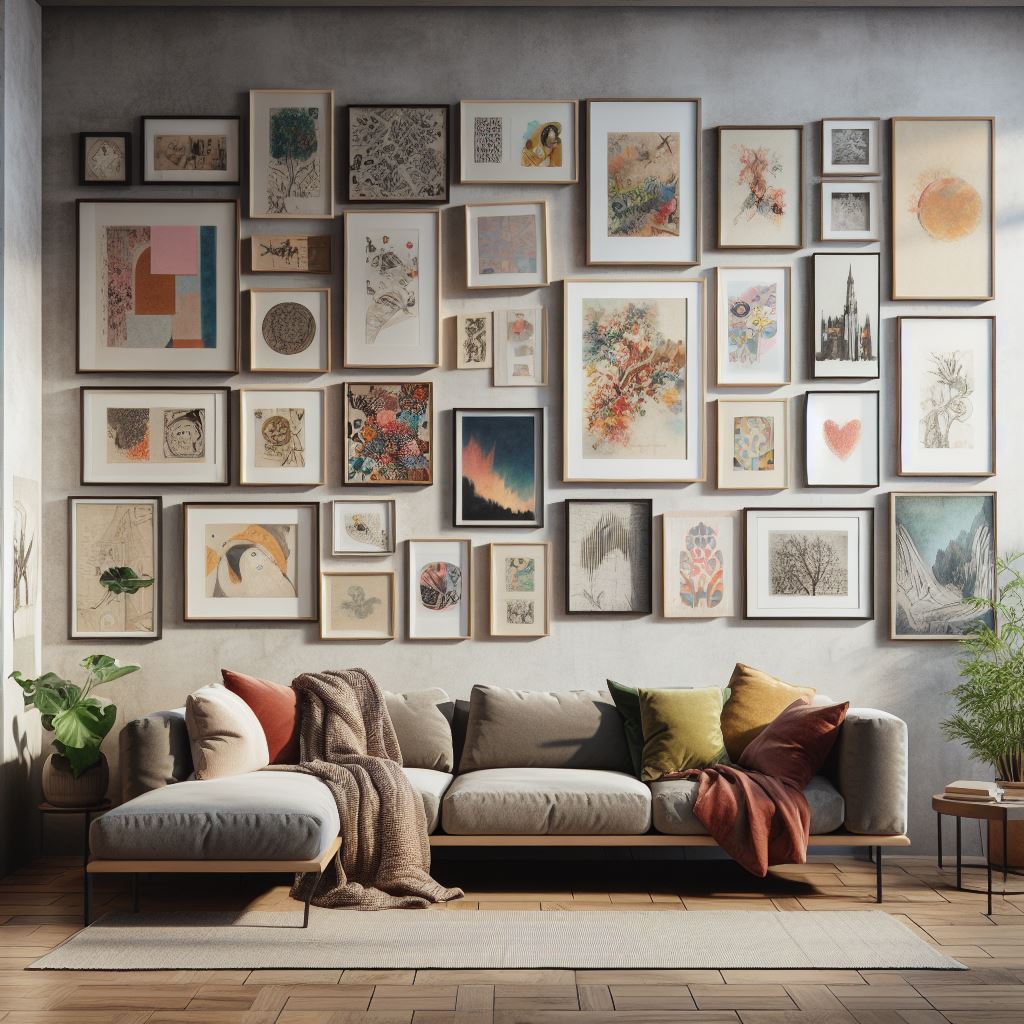
Selecting Artwork
Once you have chosen a theme and explored different art styles, it’s time to select the artwork for your gallery wall. Before diving into the exciting process of curating your collection, it’s essential to measure your wall space. This will help you determine the appropriate size and orientation of the artwork you choose.
Measure your wall space
By measuring your wall space, you can determine the maximum dimensions your artwork should have. This will prevent you from selecting pieces that are too large or too small for the wall, ensuring a visually balanced display. Take note of any architectural features, such as windows, doors, or light switches, and consider how they might impact the layout of your gallery wall.
Decide on the number of pieces
The number of pieces you choose for your gallery wall will depend on the size of your wall and the overall look you want to achieve. For smaller walls, a few well-placed artworks can create a beautiful focal point. Larger walls can accommodate more pieces, allowing for a more extensive and visually compelling display. Remember, it’s important to strike a balance between having enough artwork to make an impact while still leaving enough negative space for a visually pleasing composition.
Mix and match different sizes and orientations
To create visual interest and a sense of movement, mix and match different sizes and orientations of artwork. Pairing large and small pieces can add depth and dimension to your gallery wall. Experiment with different combinations until you find a layout that feels balanced and visually appealing. Consider using a mix of horizontal, vertical, and square-shaped artworks to create a dynamic and engaging display.
Creating a Layout
Creating a layout is an essential step in the gallery wall creation process. By laying out your artwork on the floor, experimenting with different arrangements, and considering balance and visual flow, you can ensure a cohesive and visually pleasing display.
Lay out your artwork on the floor
Before hanging your artwork, lay them out on the floor to get a sense of how they will look together. This allows you to experiment with different arrangements without committing to any specific placement. Play around with the positioning of the pieces, considering their size, orientation, and relationship to one another. Take a step back and assess the overall composition, ensuring that it achieves the desired visual effect.
Experiment with different arrangements
Don’t be afraid to get creative and try out different arrangements. Start by arranging the largest and most prominent piece of artwork as the focal point. From there, build outwards by placing complementary pieces around it. Experiment with different configurations until you find a layout that feels balanced and visually appealing. Remember to consider the height at which you will hang the artwork, as this can impact how it is perceived within the overall composition.
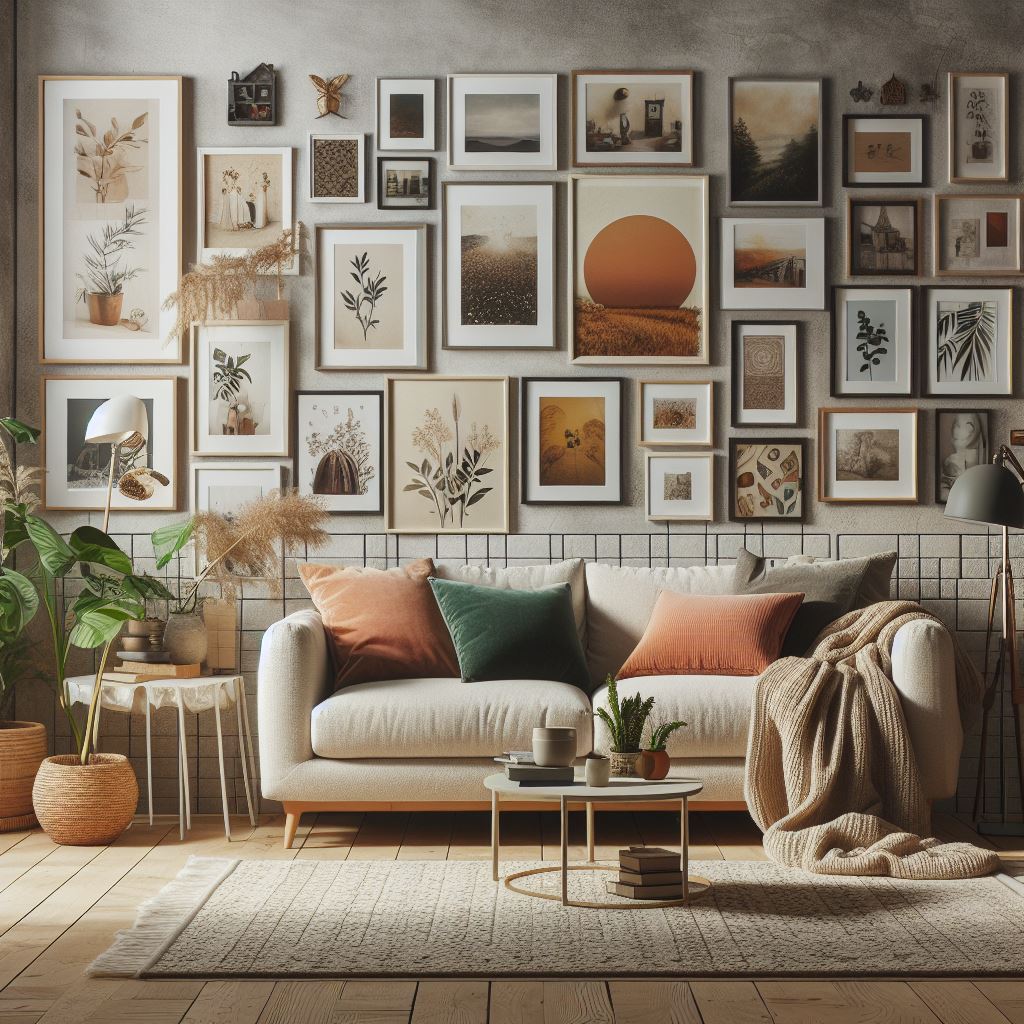
Consider balance and visual flow
Balance and visual flow are key considerations when creating a gallery wall. Aim for a sense of harmony and cohesion by distributing visual weight evenly throughout the display. This can be achieved by placing larger, more visually impactful pieces towards the center and framing them with smaller, complementary artworks. Pay attention to the relationship between positive and negative space, ensuring that the eye can move effortlessly across the gallery wall.
Preparing the Wall
Before hanging your artwork, it’s important to prepare the wall surface. By cleaning and patching any imperfections and removing existing nails or hooks, you can ensure a smooth and visually appealing backdrop for your gallery wall.
Clean and prepare the wall surface
Before hanging your artwork, give the wall surface a thorough clean to remove any dust or debris. Use a gentle cleaner and a soft cloth to avoid damaging the paint or texture of the wall. If necessary, consider using a primer or paint touch-up to freshen up the wall and ensure an even background for your artwork.
Remove any existing nails or hooks
If there are existing nails or hooks on the wall, carefully remove them and patch up any resulting holes. Use a putty knife or a wall filler compound to fill in the holes, then sand the area smooth once it dries. This will create a clean surface for hanging your artwork and prevent any unwanted distractions or unevenness in the final display.
Patch and repair any imperfections
Inspect the wall for any imperfections, such as cracks or dents, and patch them up using a suitable wall filler or spackling compound. Smooth out the patched areas with sandpaper, ensuring they blend seamlessly with the rest of the wall. This step is crucial for achieving a polished and professional-looking gallery wall.
Arranging and Hanging
Arranging and hanging your artwork is an exciting and satisfying part of the gallery wall creation process. By using a level to ensure accuracy, starting with the largest piece, and leaving enough spacing between frames, you can achieve a well-balanced and visually appealing arrangement.
Use a level to ensure accuracy
When hanging artwork, accuracy is key. Use a level to ensure that your artwork is perfectly straight. Start by placing the level on top of the piece and adjust until the bubble is centered. This will help you avoid crooked or uneven artwork, ensuring a polished and professional look for your gallery wall.
Start with the largest piece
To establish a focal point for your gallery wall, start by hanging the largest piece. This will act as an anchor for the rest of the artwork and help guide the overall arrangement. Once the largest piece is securely hung, you can build the rest of the gallery wall around it, considering the size, orientation, and relationship between the other pieces.
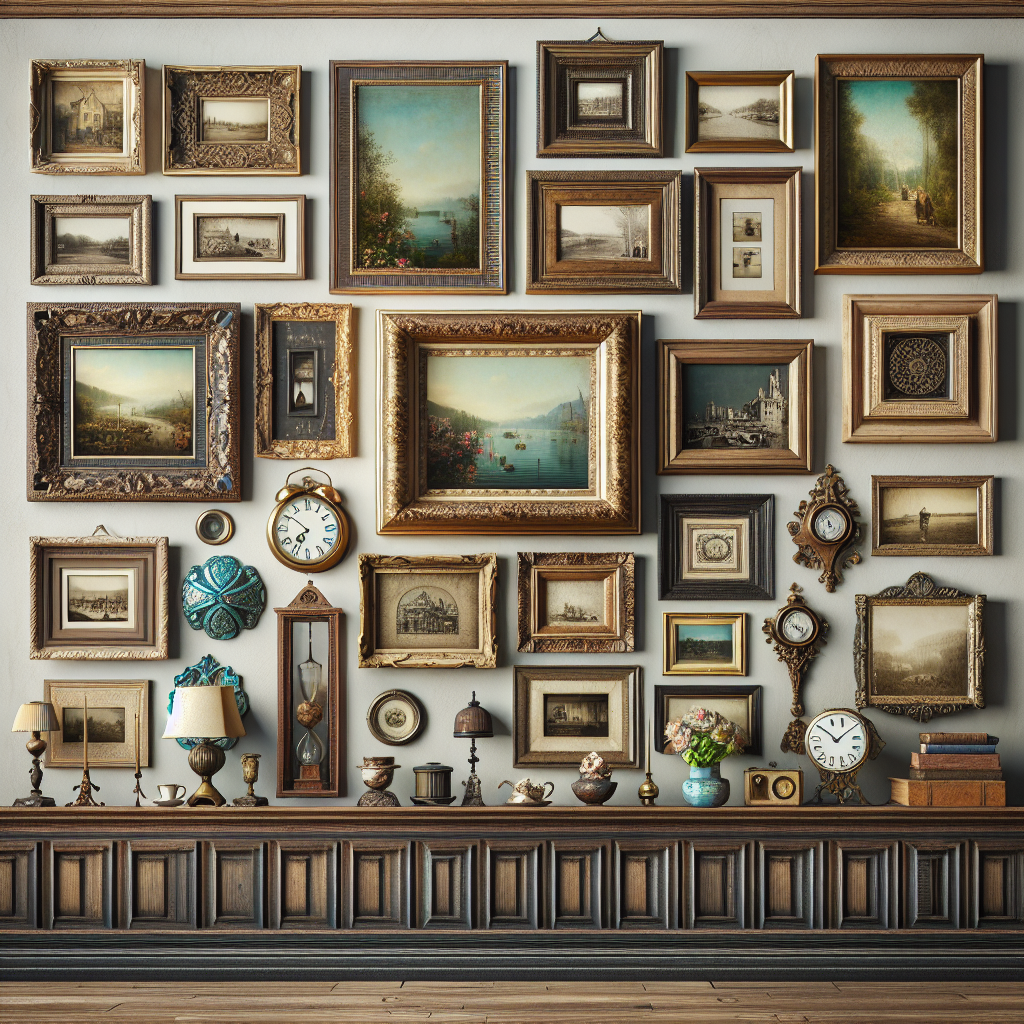
Leave enough spacing between frames
To create a visually pleasing gallery wall, leave enough spacing between frames. Aim for a consistent distance between each piece, typically around 2-3 inches. This spacing will allow each artwork to stand out individually while still maintaining a cohesive composition. Consider using paper cutouts or painter’s tape to map out the placement of each piece before committing to any nail holes.
Adding Personal Touches
One of the most enjoyable aspects of creating a gallery wall is incorporating personal touches that reflect your individuality. By including personal photographs or mementos, mixing in other decorative elements, and considering the addition of accent lighting, you can elevate your gallery wall to a whole new level.
Include personal photographs or mementos
Adding personal photographs or mementos to your gallery wall is an excellent way to infuse it with sentimental value and make it truly unique. Whether it’s family photos, travel souvenirs, or cherished keepsakes, incorporating personal items adds a personal touch to your gallery wall. Consider printing and framing meaningful photographs or displaying small mementos in shadow boxes for a visually appealing and sentimental addition.
Mix in other decorative elements
In addition to artwork, you can mix in other decorative elements to enhance your gallery wall. Consider hanging mirrors, clocks, or decorative plates to add texture and variety. Mix in different materials such as wood, metal, and glass for a visually interesting and dynamic display. By combining different decorative elements, you can create a gallery wall that transcends traditional boundaries and truly reflects your unique style.
Consider adding accent lighting
Adding accent lighting to your gallery wall can create a dramatic and eye-catching display. Consider incorporating picture lights or wall sconces to illuminate your artwork and create a focal point. This not only highlights your pieces but also adds a warm and inviting ambiance to the space. Experiment with different lighting options to find the perfect balance between functionality and aesthetics.
Accessorizing the Space
A gallery wall is not just about the artwork; it’s about the overall aesthetic of the space. By adding shelves or ledges for extra display space, incorporating hanging plants or small sculptures, and considering the use of decorative frames or borders, you can create a well-rounded and visually dynamic environment.
Add shelves or ledges for extra display space
To maximize your gallery wall’s potential, consider adding shelves or ledges for additional display space. This allows you to showcase smaller pieces or decorative objects that may not hang well on the wall. Floating shelves or picture ledges are excellent options for displaying books, small sculptures, candles, or plants, adding depth and visual interest to your gallery wall.
Incorporate hanging plants or small sculptures
To infuse your gallery wall with life and personality, incorporate hanging plants or small sculptures. Hanging plants not only add a touch of greenery but also provide a refreshing and natural element to the space. Choose plants that are suitable for indoor settings and consider their watering and care requirements. Small sculptures or decorative objects can also add texture and visual interest to your gallery wall, further enhancing its overall appeal.
Consider using decorative frames or borders
While the artwork is undoubtedly the star of the show, don’t overlook the importance of frames or borders in accentuating your gallery wall. Consider using decorative frames or borders that complement your artwork and tie the overall composition together. Play with different frame styles, colors, and materials to find the perfect match for your gallery wall. Just ensure that the frames or borders enhance, rather than overpower, the artwork itself.
Maintenance and Care
Once your gallery wall is complete, it’s essential to maintain and care for it to ensure its longevity and visual appeal. By dusting and cleaning the artwork regularly, avoiding direct sunlight to prevent fading, and ensuring proper humidity levels in the room, you can enjoy your gallery wall for years to come.
Dust and clean the artwork regularly
Artwork, like any other object, accumulates dust over time. Regularly dust and clean the artwork using a soft, lint-free cloth or a feather duster to prevent dust buildup. Pay special attention to frames and glass, ensuring that they remain clean and free from smudges or fingerprints. Cleaning your artwork regularly will help maintain its vibrancy and visual impact.
Avoid direct sunlight to prevent fading
Sunlight can cause artwork to fade over time, diminishing its original beauty. Avoid placing your gallery wall in direct sunlight, as prolonged exposure can cause colors to fade and delicate materials to deteriorate. If your space receives a lot of natural light, consider using UV-protective glass or window coverings to minimize the artwork’s exposure to harmful UV rays.
Ensure proper humidity levels in the room
Extreme changes in humidity can negatively impact artwork, causing warping, discoloration, or mold growth. Maintain proper humidity levels in the room where your gallery wall is displayed, aiming for around 50% humidity. Use dehumidifiers or humidifiers as needed to achieve a stable and suitable environment for your artwork. Regularly check for any signs of moisture or condensation and address them promptly to prevent damage.
Updating the Gallery
A gallery wall is a dynamic and ever-evolving display. Periodically updating your gallery wall can breathe new life into the space and keep it looking fresh. Consider rotating artwork, switching out frames or mats for a fresh look, and incorporating seasonal or holiday themes to celebrate various occasions and keep your gallery wall interesting.
Rotate artwork periodically
To keep your gallery wall feeling fresh and dynamic, consider periodically rotating the artwork. This allows you to showcase different pieces and experiment with new combinations. Consider changing the artwork with the changing seasons or as your tastes and preferences evolve. Rotating artwork not only keeps your gallery wall visually engaging but also allows you to appreciate and enjoy your entire art collection.
Switch out frames or mats for a fresh look
If you’re looking for a quick and cost-effective way to update your gallery wall, consider switching out frames or mats. By changing the frames or mats, you can significantly alter the look and feel of your artwork. Experiment with different frame styles, colors, or materials to achieve a desired aesthetic. This can breathe new life into your gallery wall and create a unique and personalized display.
Consider incorporating seasonal or holiday themes
To celebrate various occasions and add a touch of festivity to your gallery wall, consider incorporating seasonal or holiday themes. Swap out a few pieces to showcase artwork or decorations that correspond to different holidays or seasons. This allows your gallery wall to adapt to the changing calendar and create a dynamic and visually engaging display. Whether it’s Christmas, Halloween, or the arrival of spring, incorporating seasonal or holiday themes adds an element of fun and excitement to your gallery wall.
Seeking Professional Help
While creating a gallery wall is a fun and rewarding DIY project, there may be instances where seeking professional help is beneficial. Consulting an interior designer for expert advice, hiring a professional art installer for large or valuable pieces, and considering professional framing services can ensure a polished and cohesive gallery wall that exceeds your expectations.
Consult an interior designer for expert advice
If you’re feeling overwhelmed or unsure about creating your gallery wall, consulting an interior designer can provide valuable expertise and guidance. An interior designer can help you define your style, navigate through various art styles, and create a cohesive and visually stunning gallery wall that aligns with your overall design vision. They can provide insights into layout and composition, offer suggestions for complementary pieces, and help you source artwork that meets your aesthetic preferences.
Hire a professional art installer for large or valuable pieces
For large or valuable pieces of artwork, hiring a professional art installer can ensure their safe and secure installation. A professional art installer has the experience and expertise to handle delicate or heavy artwork, ensuring it is hung properly and securely. They can also offer valuable insights into placement and display options, maximizing the impact of your artwork. Hiring a professional for installation can provide peace of mind and ensure the longevity and visual appeal of your gallery wall.
Consider using professional framing services
If you have valuable or sentimental artwork that requires specialized framing, using professional framing services is a wise choice. Professional framers can guide you through the process of selecting the right frame style, matting, and glass options to enhance and protect your artwork. They have access to a wide range of premium materials and the expertise to handle delicate or intricate framing requirements. By utilizing professional framing services, you can elevate the presentation and longevity of your artwork, ensuring it remains well-preserved and visually impactful for years to come.
Creating a gallery wall is an exciting and creative endeavor that allows you to showcase your personality and love for art. By following these step-by-step instructions and considering the theme, artwork selection, layout, wall preparation, hanging techniques, personal touches, accessorizing, maintenance, updates, and seeking professional help as needed, you can create a gallery wall that is truly a masterpiece. So roll up your sleeves, unleash your creativity, and let your imagination run wild as you embark on this artistic journey. Your stunning gallery wall awaits!

